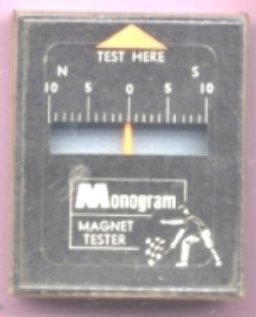Bowser recently released a skewed DC-71 open frame motor with new magnet material, for upgrading many older locos. _Many manufacturers used Pittman DC-71 motors; such as Penn-Line, Bowser, older Mantua (including possible PM-1 replacements), Varney, Hobbytown, English and others. They offer a trade-in for $ 14.98 + S & H. New motor without trade is $ 29.95. All it takes is to remove boiler or shell, 2 motor screws and wiring. Bowser will remount the gear; but to be on the safe side, you may want to remove it and set it aside. With a little more effort most high current, similar sized, Japanese KTM, open frame, motors can be replaced.

Note: Adjust brightness and contrast for optimum viewing.
Original Pittman DC-71.

Note: Adjust brightness and contrast for optimum viewing.
Bowser skewed, new magnet DC-71.
In the windings, it is difficult to determine any changes in wire size or number of turns; but resistance readings appeared to be about 4 ohms for the old and 6.5 ohms for the new. The new magnet is approximately half the cross sectional area of the original. Measured on a Monogram Magnet Tester, it appears to be about 4 times stronger.

Note: Adjust brightness and contrast for optimum viewing.
Monogram Magnet Tester.
From the slot car craze era, the tester is not calibrated to any units, but is useful for comparison and checking for demagnetization.
Unfortunately, the shaft is a very loose fit for standard bored gears. Measuring .089", it is undersized for American 3/32" = .09375" at .00475 and for metric 2.4 mm = .09449" at .0055 . After fastening with gap filling CA cement, the bond broke loose in only about 15 minutes running with a 15 car train. For a press fit and better centering, a .003" shim should be wrapped around shaft. Careful soldering may produce a better bond. The shaft size should be corrected in future runs.
Although loco characteristics vary, testing on a track is far more indicative than bench testing. For comparison the same loco and gears should be used with only a motor swap.
Running light, a Penn-Line lead boiler, L-1, was tested at 12 V with an original DC 71 motor, 62" drivers and 29/1 gears. Then 15 Train Miniature 40' boxcars were added behind it. After a motor swap, the tests were repeated.
| TEST RESULTS | |||
|---|---|---|---|
SMPH |
RPM |
AMPS | |
| |
|||
The slight difference in speed could be attributed to setting the 12 V, better alignment of motor shaft or the design, which may have shifted the speed load line.
Basically it appears to be a direct replacement for older DC-71 motors with very slight operational changes, except lower current draw. Due to the skewed armature, the low end performance was very much quieter and smoother, particularly during acceleration and deceleration. Further testing under various loads will follow as time permits.
Bowser should be encouraged to convert their other motors with correct shaft size. These could provide easy conversions for improved operation. Stall torque and other measurements are compared in STALL TORQUE DATA ,
BACK TO MOTOR EVALUATION INDEX
BACK TO REPOWERING EXAMPLES
BACK TO REMOTORING
BACK TO SUPER MOTOR
